murder
 As we all know, Adolph Hitler was a liar and a murderer. He really never made a move that wasn’t calculated and devious. On September 1, 1939, German forces under the control of Adolf Hitler bombarded Poland on land and from the air. The invasion was more than just a taking of territory. Hitler knew that he might need that area later, and so he did. Hitler had been murdering people that didn’t fit into his mold of “life that had value” and that included Jews, the mentally or physically handicapped, and later gypsies and other ethnicities. Basically, he wanted to eliminate anyone that wasn’t Aryan. Aryan is a word relating to a hypothetical ethnic type illustrated by or descended from early speakers of Indo-European languages. To Hitler it meant white, with blond hair and blue eyes. Oddly, while Hitler had blue eyes, his hair was brown. Somehow that “problem” with his definition of Aryan didn’t concern Hitler. I guess he was happy to be a “special Aryan.” In reality, there are different kinds of Aryans. They can be found with blond, red, brown, white, or black hair, so that wasn’t really an issue either. Hitler considered himself Aryan because he was a native German-speaker, and he knew the definition of “Aryan” as it was used in those days. I don’t think it was ever about Aryan, per se, but rather about getting rid of any group that he decided that he didn’t like.
As we all know, Adolph Hitler was a liar and a murderer. He really never made a move that wasn’t calculated and devious. On September 1, 1939, German forces under the control of Adolf Hitler bombarded Poland on land and from the air. The invasion was more than just a taking of territory. Hitler knew that he might need that area later, and so he did. Hitler had been murdering people that didn’t fit into his mold of “life that had value” and that included Jews, the mentally or physically handicapped, and later gypsies and other ethnicities. Basically, he wanted to eliminate anyone that wasn’t Aryan. Aryan is a word relating to a hypothetical ethnic type illustrated by or descended from early speakers of Indo-European languages. To Hitler it meant white, with blond hair and blue eyes. Oddly, while Hitler had blue eyes, his hair was brown. Somehow that “problem” with his definition of Aryan didn’t concern Hitler. I guess he was happy to be a “special Aryan.” In reality, there are different kinds of Aryans. They can be found with blond, red, brown, white, or black hair, so that wasn’t really an issue either. Hitler considered himself Aryan because he was a native German-speaker, and he knew the definition of “Aryan” as it was used in those days. I don’t think it was ever about Aryan, per se, but rather about getting rid of any group that he decided that he didn’t like.
Hitler’s main purpose for the invasion of Poland was to regain lost territory and ultimately rule their eastern neighbor. Mostly, however, Hitler wanted the world to know exactly how he planned to wage war. This would become the “blitzkrieg” strategy. The Blitzkrieg was a term used to describe “a method of offensive warfare designed to strike a swift, focused blow at an enemy using mobile, maneuverable forces, including armored  tanks and air support. Such an attack ideally leads to a quick victory, limiting the loss of soldiers and artillery. After the German forces had plowed their way through, devastating a swath of territory, infantry moved in, picking off any remaining resistance.”
tanks and air support. Such an attack ideally leads to a quick victory, limiting the loss of soldiers and artillery. After the German forces had plowed their way through, devastating a swath of territory, infantry moved in, picking off any remaining resistance.”
Hitler was methodical. He established a base of operations within the target country. Then, he immediately began setting up “security” forces to take out anyone who disagreed with his Nazi ideology, whether racial, religious, or political. He set up concentration camps for slave laborers and the extermination of uncooperative civilians. It didn’t take long for the target nation, in this case Poland to become a conquered nation under German rule. Just one day after the German invasion of Poland, Hitler was busy setting up SS “Death’s Head” regiments to terrorize the people. He was preparing for his planned terror.
The Polish army tried to fight back, but they made several severe strategic miscalculations in those early days. Even with an army of 1 million soldiers, the lack of the necessary equipment was a severe detriment to the Polish forces as they attempted to take the Germans head-on, when maybe they should have fallen back to defensive positions. I think the natural way to face an enemy, is head-on. We try to “show no fear” when attacked, but in the end, this thinking, while admirable was probably behind the times, at least in battle, and the brave Polish soldiers were no match for the overwhelming and modern-mechanized German forces. To make matters worse, any hope the Polish soldiers might have had of a Soviet counter-response was lost with  the signing of the Ribbentrop-Molotov Nonaggression Pact…”a non-aggression pact between Nazi Germany and the Soviet Union that partitioned Eastern Europe between them. The pact was signed in Moscow on 23 August 1939 by German Foreign Minister Joachim von Ribbentrop and Soviet Foreign Minister Vyacheslav Molotov and was officially known as the Treaty of Non-Aggression between Germany and the Union of Soviet Socialist Republics. Unofficially, it has also been referred to as the Hitler–Stalin Pact, Nazi–Soviet Pact or Nazi–Soviet Alliance.” Germany invaded Poland on September 1, 1939. Great Britain responded with bombing raids over Germany three days later.
the signing of the Ribbentrop-Molotov Nonaggression Pact…”a non-aggression pact between Nazi Germany and the Soviet Union that partitioned Eastern Europe between them. The pact was signed in Moscow on 23 August 1939 by German Foreign Minister Joachim von Ribbentrop and Soviet Foreign Minister Vyacheslav Molotov and was officially known as the Treaty of Non-Aggression between Germany and the Union of Soviet Socialist Republics. Unofficially, it has also been referred to as the Hitler–Stalin Pact, Nazi–Soviet Pact or Nazi–Soviet Alliance.” Germany invaded Poland on September 1, 1939. Great Britain responded with bombing raids over Germany three days later.
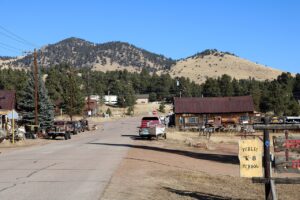
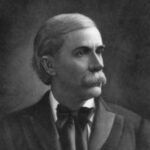 The town of Guffey, Colorado got its start in 1890 with the promise of gold and big money. It quickly attracted prospectors from all over the country. The Cripple Creek mine was just 30 miles away from town, and so the town was the perfect supply hub for mining claims that were expected to spring up between Cripple Creek and Guffey. When Guffey was established, the mining camp was called Idaville, but shortly thereafter its name was changed to Freshwater.
The town of Guffey, Colorado got its start in 1890 with the promise of gold and big money. It quickly attracted prospectors from all over the country. The Cripple Creek mine was just 30 miles away from town, and so the town was the perfect supply hub for mining claims that were expected to spring up between Cripple Creek and Guffey. When Guffey was established, the mining camp was called Idaville, but shortly thereafter its name was changed to Freshwater.
Guffey was actually legally incorporated in 1895, and it was immediately booming as a mining, lumbering, and ranching community. The Freshwater Mining District wasn’t just about gold mines. The area also produced copper, lead, and other minerals. The minerals that could be mined in the area made Guffey a center of activity. For most, gold was the big draw, mostly because they didn’t understand the value of the other minerals, like we do now, with new technologies and new uses for minerals. On August 31, 1896, the Colorado Daily Chieftain reported, “All of the arrangements have been completed, and negotiations closed for the construction of a cyanide mill on Currant Creek, of a capacity of 60-tons per day. The mill is now assured beyond any doubt, and ground will be broken for its construction within a fortnight. The capitalists behind the enterprise are Roadhaven and Vanderpool, of Saint Louis, who have visited the camp several times, investigating our mines and ores, with William Goodman of Cripple Creek, who has been largely instrumental in consummating this enterprise. They claim to be able to treat $7 ore at a profit, which it is claimed will make of Freshwater the biggest camp in the world. The townspeople have guaranteed the company 50 tons of ore per day. This step locates Freshwater beyond the boundary of a prospecting camp and places it in the list of producers.”
The town would receive another name change in the late 1890s, this time due to the fact that there was another town with the same name in California. In honor of James McClurg Guffey, an oilman and capitalist, the town was named Guffey. The town was known throughout the region for its dances, which included lots of fiddlers and other musicians. Guffy reached its peak during this period, with over 500 residents and 40 businesses…most of which were brought in with the promise of gold.
While there were many mines and prospects around Guffey, the total production recorded was disappointingly minor. The cattle ranches and lumber operations located nearby supported Guffey while mining wasn’t profitable. In reality, the town was probably more suited for ranching anyway. Soon many of the businesses began to leave. The Park County Bulletin, dated January 17, 1902, stated, “With this issue, the GUFFEY PROSPECTOR will cease publication. This is due in part to the fact that the camp has another paper and to the additional fact that the Freshwater districts have failed, so far, to develop sufficiently to support a newspaper. The PROSPECTOR has for some time been published from the BULLETIN office, and while working faithfully for the camp, it has never been a paying investment. Those in the Freshwater districts who wish to settle their accounts with the paper can do so with Captain Sylvis at the Guffey post office. To those who wish it, the BULLETIN will be continued to their address, and we will try to make it meet their requirements as always up with the news of Park County. We still have faith in the Freshwater districts and believe that, when sufficient depth has been obtained, there will be pay mines made and profitable mining is done.”
Before long, the people started to move away too. While Guffey still exists today, the community has only around 49 residents and relies heavily on tourism. There are still several of the original structures remaining and are actually occupied. The others have been kept up, though empty, so that the town can keep its historic value and possible income potential for the future. The town currently has a charter school, restaurant, small museum, and more. Guffey continues to be the center of activity for nearby ranches, some of which are Park County Historic Landmarks, including the Aspen Creek/Bener/Moore Ranch, Campbell Ranch, and Thirty-One-Mile Ranch. So, while the town’s size has dwindled, its usefulness has not. Guffey also sits in a very scenic area created by three ancient volcanoes. The Guffey volcanic center is part of the Thirty-nine Mile Volcanic area, the largest remnant of the Central Colorado volcanic field. There are two mineral springs just a mile south of Guffey, that feature spring waters bubbling up from large mounds over 20 feet high and 50 feet across.
Sadly, not all is well in Guffey. As in any town, crime can happen. In January 2001, the bodies of three members of the Dutcher family were found near Guffey. They had been murdered. Later, three teenagers were convicted of the crime. Apparently these three boys had decided to form a paramilitary organization. They were supposedly practicing for future action they planned to take in the country of Guyana. The murders were part of their “practice sessions.” The brutal nature of the crime and its bizarre motive attracted national attention, but really not the kind of attention that the town wanted to be famous for.
The town does have some real oddities that it doesn’t mind being famous for. It would be considered a “somewhat ghost town” and strangely, has a habit of electing animals as Mayor. In fact, while the two main political parties are the Democrats and the Republicans, the current Mayor, Monster the Cat was elected in 
 1998. Lydia Reynolds of Guffey’s 31 Mile Ranch and Bill Sioux of Guffey Garage left us a comment confirming Monster was still alive and well…as of November 2019 anyway. I suppose that in a small town, you could get away with an animal as mayor, but for most of us, that would definitely be odd. Nevertheless, I guess it just adds to the charm of this quaint, old town.
1998. Lydia Reynolds of Guffey’s 31 Mile Ranch and Bill Sioux of Guffey Garage left us a comment confirming Monster was still alive and well…as of November 2019 anyway. I suppose that in a small town, you could get away with an animal as mayor, but for most of us, that would definitely be odd. Nevertheless, I guess it just adds to the charm of this quaint, old town.
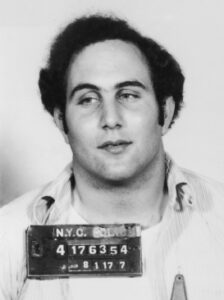 Mental illness can cause people to do insane things. On August 10, 1977, a 24-year-old postal employee named David Berkowitz was arrested and charged with being the “Son of Sam” serial killer who terrorized New York City for more than a year. He killed six young people and wounded seven others with a .44-caliber revolver. Serial killers have a specific type of target victim, and Berkowitz generally targeted attractive young women with long brown hair. The women in New York City were so frightened that hundreds of young women had their hair cut short and dyed blonde during the time “Son of Sam” terrorized the city. Thousands more women were too scared to even leave their homes at night.
Mental illness can cause people to do insane things. On August 10, 1977, a 24-year-old postal employee named David Berkowitz was arrested and charged with being the “Son of Sam” serial killer who terrorized New York City for more than a year. He killed six young people and wounded seven others with a .44-caliber revolver. Serial killers have a specific type of target victim, and Berkowitz generally targeted attractive young women with long brown hair. The women in New York City were so frightened that hundreds of young women had their hair cut short and dyed blonde during the time “Son of Sam” terrorized the city. Thousands more women were too scared to even leave their homes at night.
August 10th finally brought his reign of terror to an end. After his arrest, Berkowitz claimed that demons and a black Labrador retriever owned by a neighbor named Sam had ordered him to commit the killings. These statements were the first signs that Berkowitz was a Paranoid Schizophrenic…a condition he was later diagnosed with. Mental illness is not an excuse for murder, but I suppose it is an explanation of sorts. David Berkowitz was born Richard David Falco on June 1, 1953, in Brooklyn, New York. His biological mother, Elizabeth “Betty” Broder, placed him for adoption within a few days. His biological father, Joseph Klineman was a married man with whom Broder had a three-year affair. ? The exact reason for Broder’s decision is unknown, but it has been speculated that Klineman threatened to leave her if she kept the baby and if she used his name. Although her reasons for giving Richard away are unknown, have surmised that Klineman threatened to abandon her if she kept the baby and used his name. Broder had grown up as part of an impoverished Jewish family and was working as a waitress. Prior to meeting Klineman, in 1936. She married Tony Falco, an Italian American, who left her for another woman less than four years later. David Berkowitz was adopted by Pearl and Nathan Berkowitz. David loved his adoptive parents and did well until he was traumatized by the death of his adoptive mother from cancer in 1967. That event caused him to become a recluse. In 1971, Berkowitz joined the army and served for three years. He seemed to be in his element and distinguished himself as a talented marksman. In 1974, he returned to New York and worked as a security guard, but his mental condition began to severely deteriorate in 1975. Still a recluse, he began to feel very isolated from the world around him, and he set hundreds of arson fires in New York without being caught.
It was at this time that he began to hear voices of, in his own words, “demons” that tormented him and told him to commit murder. His first attempt came on Christmas Eve, 1975, when is gave into the “demons” and severely wounded 15-year-old Michelle Forman with a hunting knife. In January 1976, after moving into a two-family home in Yonkers, Berkowitz became convinced that the German shepherd that lived in the house and other neighborhood dogs were possessed by demons who ordered him to murder attractive young women. It seems so strange that he connected dogs with the voices his disease caused him to hear. Then his condition progressed, and he also started seeing his neighbors as demons. In April, Berkowitz moved to an apartment house in Yonkers, but this new home also had dogs. His neighbor, retiree Sam Carr, had a black Labrador retriever named Harvey, who Berkowitz believed pleaded with him to kill. He also saw Sam Carr as a powerful demon and was referring to him when he began calling himself “Son of Sam.” On July 28, 1976, Berkowitz quit his job as a security guard, and the killing spree began. Over the next year, Berkowitz killed 6 women. He wounded 11 more, two of which were actually stabbed in 1975. His fatal victims were Donna Lauria, Christine Freund, Virginia Voskerichian, Valentina Suriani, Alexander Esau (Esau was only killed because he was in the way as he kissed Valentina Suriani), and Stacy Moskowitz who was also kissing her boyfriend. Bobby Violante, lost his left eye and nearly all the vision in his right eye, but he lived.
Finally getting a ballistics match after the killing of Virginia Voskerichian, it was determined that this was a serial killer. The New York police announced that a serial killer was on the loose, known to be a white male in his 20s, with black hair and of average height and build. A task force was assembled, called “The Omega Task Force.” Berkowitz was getting brave, now leaving a note with his victims identifying himself as “Son of Sam.” Then, on April 29, Berkowitz shot Sam Carr’s Labrador retriever. He had previously sent an anonymous, threatening letter to Mr Carr concerning the animal. The dog recovered, and the Yonkers police began an investigation. Then, Berkowitz started sending insane letters to other neighbors and his former landlords. These people began to suspect Berkowitz and called the police. individuals began to suspect Berkowitz to be the Son of Sam and reported their suspicions to local police. Still, the detectives of The Omega Task Force, even after receiving thousands of reports of Son of Sam “suspects” and were nevertheless having a difficult time sifting through all the dead-end leads.
On June 26, the Son of Sam struck again, wounding Judy Placido and Sal Lupo as they sat in their car after leaving a Queens disco. A few days later, a major break in the case came when an eyewitness came forward to report that she had seen a man with what looked like a gun minutes before the shots were fired in Brooklyn. Her information led to the first police sketch of Berkowitz. More important, she reminded investigators that two police officers had been writing parking tickets on her street that night. A search of tickets issued eventually turned up Berkowitz’s car. At the same time, Yonkers police investigated Berkowitz after he escalated a harassment campaign against one of his neighbors. Convinced he was the “Son of Sam” they informed the Omega task force of their findings. The Omega detectives finally put two and two together, and on August 10 David Berkowitz was arrested while leaving his Yonkers home. He excitedly admitted to being the “Son of Sam.” It was like it had all been a game of “hide and seek” in his mind. At the time, he had his semiautomatic rifle. He told them that he was on his way to commit another murder. The .44-caliber revolver was also recovered. 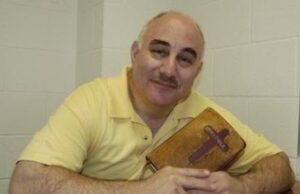 There was some question about whether Berkowitz was mentally fit to stand trial, but on May 8, 1978, he changed his insanity plea to guilty on six counts of murder. The whole time, he seemed to enjoy the publicity. The case prompted New York state to adopt the first in a nationwide series of so-called “Son of Sam laws” that take proceeds a criminal earns from selling their story and gives them to a victims’ compensation fund.
There was some question about whether Berkowitz was mentally fit to stand trial, but on May 8, 1978, he changed his insanity plea to guilty on six counts of murder. The whole time, he seemed to enjoy the publicity. The case prompted New York state to adopt the first in a nationwide series of so-called “Son of Sam laws” that take proceeds a criminal earns from selling their story and gives them to a victims’ compensation fund.
Berkowitz was given six 25-years-to-life sentences for the crime, the maximum penalty allowed at the time. He has since been denied parole. He is currently held at the Shawangunk Correctional Facility in upstate New York, where he allegedly converted to Christianity. I pray that is so.
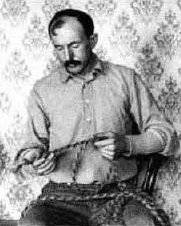 Being wrongly convicted of a crime is a nightmare that more than a few people have faced in their lifetime. As detective work and forensics have improved over the years, it happens less often, but that was not always the case. On July 18, 1901, Willie Nickell, the 14-year-old son of sheep ranchers Kels and Mary Nickell, was found murdered near their homestead gate near Iron Mountain, Wyoming. More violent incidents occurred during the period of the coroner’s inquest, which was expanded to investigate these incidents and lasted from July through September 1901. In the end investigation centered on a man named Tom Horn.
Being wrongly convicted of a crime is a nightmare that more than a few people have faced in their lifetime. As detective work and forensics have improved over the years, it happens less often, but that was not always the case. On July 18, 1901, Willie Nickell, the 14-year-old son of sheep ranchers Kels and Mary Nickell, was found murdered near their homestead gate near Iron Mountain, Wyoming. More violent incidents occurred during the period of the coroner’s inquest, which was expanded to investigate these incidents and lasted from July through September 1901. In the end investigation centered on a man named Tom Horn.
Thomas Horn Jr was born on November 21, 1860, to Thomas S Horn Sr and Mary Ann née Miller Maricha on their family farm in rural northeastern Scotland County, Missouri. Horn was an American scout, cowboy, soldier, range detective, and Pinkerton agent in the 19th-century and early 20th-century American Old West. It is believed that he committed 17 killings as a hired gunman throughout the West. Horn was convicted in 1902 of the murder of young Willie Nickell.
While Horn was convicted of the murder, it was a known fact that Willie’s dad, Kels Nickell was involved in a range feud with his neighbor and cattle rancher Jim Miller. To me, that would throw up an immediate red flag into the situation, but because Horn was a known hired gun, the jury convicted him of murder on October 24, 1901. Horn rigorously appealed the conviction, but he lost that battle, and on November 20, 1903, the infamous hired killer Tom Horn was hanged for having murdered Willie Nickell.
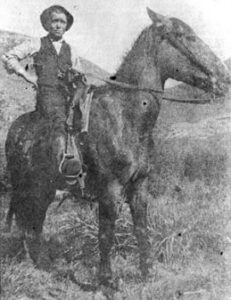 Looking back, a number of historians have questioned whether Horn really killed the boy. They have pointed out that the jury convicted him solely on the basis of a drunken confession that Horn supposedly made to a detective. The jury also seems to have failed him, by refusing to take note to the testimony of a number of credible witnesses who claimed Horn could not possibly have committed the crime. Yet even Horn’s defenders in the Nickell case do not dispute that he was a brutal hired killer who was unquestionably responsible for many other deaths. Nevertheless, he was not on trial for those other deaths. It’s quite possible that the people figured it was better to get a hired gun off the streets, even if it was for a crime he couldn’t possibly have committed…a public service of sorts, I suppose. Other historians suggest that Horn may have murdered Willie Nickell by accident, having mistaken the boy for his father. Still others argue that it is more likely that Horn was deliberately convicted for a crime he did not commit by Wyoming citizens seeing an opportunity to take revenge. We will never know for sure.
Looking back, a number of historians have questioned whether Horn really killed the boy. They have pointed out that the jury convicted him solely on the basis of a drunken confession that Horn supposedly made to a detective. The jury also seems to have failed him, by refusing to take note to the testimony of a number of credible witnesses who claimed Horn could not possibly have committed the crime. Yet even Horn’s defenders in the Nickell case do not dispute that he was a brutal hired killer who was unquestionably responsible for many other deaths. Nevertheless, he was not on trial for those other deaths. It’s quite possible that the people figured it was better to get a hired gun off the streets, even if it was for a crime he couldn’t possibly have committed…a public service of sorts, I suppose. Other historians suggest that Horn may have murdered Willie Nickell by accident, having mistaken the boy for his father. Still others argue that it is more likely that Horn was deliberately convicted for a crime he did not commit by Wyoming citizens seeing an opportunity to take revenge. We will never know for sure.

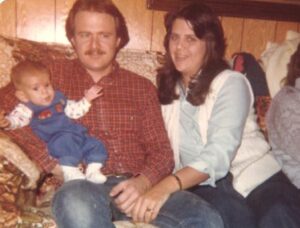 No one wants to think about an innocent person going to prison for a crime they did not commit, and I like to think that it doesn’t happen very often, but I think there was a time when it was a little more common that it is these days. While it may not happen as often these days as it used to, more and more of these wrongful incarcerations are coming to light these days, because of DNA testing. Michael Morton (born August 12, 1954) was convicted in a Williamson County, Texas court in 1986, of murdering his wife, Christine Morton. He never gave up the fight. He maintained in innocence until the end, and in the end, it was proven that he was in fact, innocent. Unfortunately, that did not mean that he was spared a prison sentence. He actually spent almost 25 years behind bars, sadly.
No one wants to think about an innocent person going to prison for a crime they did not commit, and I like to think that it doesn’t happen very often, but I think there was a time when it was a little more common that it is these days. While it may not happen as often these days as it used to, more and more of these wrongful incarcerations are coming to light these days, because of DNA testing. Michael Morton (born August 12, 1954) was convicted in a Williamson County, Texas court in 1986, of murdering his wife, Christine Morton. He never gave up the fight. He maintained in innocence until the end, and in the end, it was proven that he was in fact, innocent. Unfortunately, that did not mean that he was spared a prison sentence. He actually spent almost 25 years behind bars, sadly.
On the afternoon of August 13, 1986, a neighbor found 31-year-old Christine Morton beaten to death in her bed in the Williamson County, Texas, home near Austin, that she shared with Michael, a grocery store manager, and their 3-year-old son, Eric. The investigation began, and six weeks later, Morton, who had no criminal record or history of violence, was arrested for Christine’s murder. At trial, the prosecution contended Morton had slain his wife of seven years after she refused to have sex with him on the night of August 12, his 32nd birthday. Morton stated repeatedly that he had nothing to do with his wife’s death and said an intruder must have killed her after he left for work early on the morning of August 13. No witnesses or physical evidence linked Morton to the crime. There wasn’t anything circumstantial or ever really anything alleged to connect him to the crime, except that he had access to the home. Nevertheless, Michael Morton was convicted on February 17, 1987, and sentenced to life behind bars. So began his nightmare.
During his trial and subsequent time in prison, Morton’s defense team asked the state to test DNA on a variety of items, including a blood-stained bandanna found by police the day after the murder at an abandoned construction site close to the Morton home. For whatever reason, the Williamson County district attorney successfully blocked all requests for testing until 2010, when a Texas appeals court ordered that testing on the bandana take place. The team’s persistence finally paid off. The test results revealed the bandana contained Christine Morton’s blood and hair, along with the DNA of another man, Mark Alan Norwood, who was a felon with a long criminal record. Norwood had worked in the Austin area as a carpet layer at the time of the murder.
Finally, after waiting almost 25 years for real justice, Michael Morton was released on October 4, 2011. A month after Morton was freed, Norwood, who was by then 57, was arrested for Christine Morton’s killing. In March 2013, he was found guilty of her murder and sentenced to life in prison. Based on DNA evidence, Norwood also was indicted for killing a second woman, Debra Baker, whose 1988 murder in Austin had remained unsolved. Like Morton, Baker was bludgeoned to death in her bed. She lived just blocks from Norwood at the time of her murder. Michael Morton was officially exonerated in December of that year.
After a yearlong investigation into prosecutor, Ken Anderson, the State Bar of Texas filed a disciplinary petition against Ken Anderson in October 2012. By then, the prosecutor was a Texas district, elected in 2002. The Texas State Bar alleged that Anderson had withheld various pieces of evidence from Morton’s attorneys, including a transcript of an August 1986 taped interview between the case’s lead investigator and Morton’s mother-in-law, in which she stated that Morton’s then 3-year-old son, Eric had told her in detail about witnessing his mother’s murder and said his father was not home at the time. Anderson managed to pull off a plea deal to settle the charges against him. He agreed to serve 10 days in jail, perform 500 hours of community service, give up his law license and pay a $500 fine. I think that is an outrageous miscarriage of justice. He had knowingly withheld evidence that cost another man 25 years of his life. He should have had to serve the same length of time.
Morton was later able to re-establish contact with his son, who had cut ties with him when he was fifteen, because he then believed that he had not remembered the incident correctly, and it was his dad who had killed 
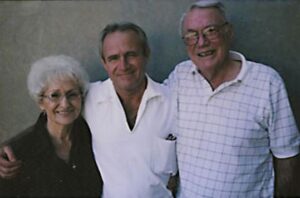 his mom. A further miscarriage of justice that was handed down to the elder Morton. He had not only lost 25 years of his own life, but an additional 13 years of his son’s life. Thankfully, Christine Morton’s sister adopted Eric Morton, so his dad was able to find his son when he got out of prison. When his was released, Morton lived with his parents in Liberty City, Texas for a while, before moving to Kilgore, Texas. In 2013, Morton married Cynthia May Chessman, who he met at his church.
his mom. A further miscarriage of justice that was handed down to the elder Morton. He had not only lost 25 years of his own life, but an additional 13 years of his son’s life. Thankfully, Christine Morton’s sister adopted Eric Morton, so his dad was able to find his son when he got out of prison. When his was released, Morton lived with his parents in Liberty City, Texas for a while, before moving to Kilgore, Texas. In 2013, Morton married Cynthia May Chessman, who he met at his church.

 A couple of days ago, my husband, Bob Schulenberg and I went for a hike through a South Dakota ghost town called Spokane. It was founded in 1890 to extract precious gold, the mine proved richer in silver, copper, zinc, mica and graphite. The town hit its stride in 1927 with its biggest year ever totaling $144,742 in profits which helped fund the school building whose bones can still be seen, at least for now. The tow is rapidly deteriorating, so they won’t be around much longer. By 1940, the mine and town were all but abandoned. The town limped along, with the manager’s house being the last one to be abandoned in the 1970s. The Spokane Mine was discovered in 1889 by Sylvester Judd more or less by accident. As the story goes, “he had placed a rock (likely galena or cerussite) from the outcrop on his wooden stove. He was amazed when he found molten lead coming from the mineral.” The town was formed the same year the mine began operations, in 1890, but it was not the town or it’s dilapidated buildings, but rather the tragic history of the place that caught my attention.
A couple of days ago, my husband, Bob Schulenberg and I went for a hike through a South Dakota ghost town called Spokane. It was founded in 1890 to extract precious gold, the mine proved richer in silver, copper, zinc, mica and graphite. The town hit its stride in 1927 with its biggest year ever totaling $144,742 in profits which helped fund the school building whose bones can still be seen, at least for now. The tow is rapidly deteriorating, so they won’t be around much longer. By 1940, the mine and town were all but abandoned. The town limped along, with the manager’s house being the last one to be abandoned in the 1970s. The Spokane Mine was discovered in 1889 by Sylvester Judd more or less by accident. As the story goes, “he had placed a rock (likely galena or cerussite) from the outcrop on his wooden stove. He was amazed when he found molten lead coming from the mineral.” The town was formed the same year the mine began operations, in 1890, but it was not the town or it’s dilapidated buildings, but rather the tragic history of the place that caught my attention.
A man named James Shepard, or Jim as he was know to family and friends in Spokane, heard about the gold rush in the Black Hills and decided to take his family from North Carolina, to the town of Spokane to stake his claim. A local man named Frank Cox had not kept up assessment work on the Spokane Mine, which he himself had “jumped” when it had been neglected by someone else. It isn’t the best way to stake a claim, but it is legal apparently. Jim had enough to stake his claim to the mine, so he claimed it and on June 21, 1908, when he drove his stake at the site. Jim was well liked and since he did things right, people respected him and his family.
Frank Cox’s wife, the Sunday school teacher, observed the staking of the claim by Shepard while riding to the schoolhouse and informed her husband. Then the real trouble began. That evening, Jim rode his horse to bring his free-roaming milk cow back to the house. According to his account, when he had his guard down, Frank and his son Henry stepped out from behind some trees. Frank yelled, “You son-of-a-bitch, you have driven your last stake!” and shot Jim with a shotgun. He was able to ride home, where his wife, Jessie, frantically helped him into bed and rode for help.
Jessie went to the Hoffman home and told them that Jim had been shot. Edgar H. Hoffman, who was 12 years old, never forgot that night. “Mrs. Shepard was a tall, dark mountain woman. Her clothes and the saddle were soaked and spotted with blood,” he said. A neighbor rode to the nearest doctor, but that was 17 miles away in Custer. It was an awful stormy night with heavy rain and lightning flashes. Not an easy way to make such an important trip. The next morning, the doctor and sheriff arrived to just in time to hear hear Jim’s dying words…words that incriminated Frank and Henry. The town was horribly shaken by the murder. The crowd could only be described as “angry and hostile” at Jim’s funeral.
“In order to prevent violence, the minister had the congregation point the finger of guilt at whoever they felt had committed the murder. Everyone pointed the finger at the Cox house. From then on, the Coxes were ostracized by the Spokane community and they sent their son away to relatives,” wrote Inez Shepard Shafer, Jim Shepard’s only surviving child.
In the July 10, 1909 edition of the Keystone Record, it was stated that the trial was “one of the longest and hardest fought preliminary hearings ever held in Custer County. It was thought at first by friends of Cox that he would have no trouble in proving an alibi, as he was at the Ideal [mine] all day Sunday and slept there that night. This is true, but there was about an hour and a half in the evening he was unable to account for, and about the time the shooting was supposed to have taken place. It is unfortunate for all concerned, and if Cox proves his innocence, and many believe he will, the chances are we will never know who killed James Shepard.”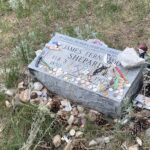

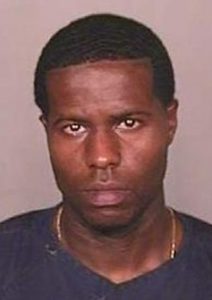 Prisoners have tried to escape ever since there have been prisons. It is the nature of the situation. No one likes to be locked up. Most escape attempts are not successful, and few are what we would consider well planned, but in the case of Florida prison inmates, Charles Walker and Joseph Jenkins, some kind of good planning must have gone into the escape plan. The two men were serving life sentences, without the possibility of parole, for murder, and so I guess they had nothing to lose by getting caught in an escape attempt. Jenkins was incarcerated for a 1998 murder and armed robbery and a 1997 auto theft. He has been in prison since 2000. Walker was imprisoned for a 1999 murder and has been in custody since 2001.
Prisoners have tried to escape ever since there have been prisons. It is the nature of the situation. No one likes to be locked up. Most escape attempts are not successful, and few are what we would consider well planned, but in the case of Florida prison inmates, Charles Walker and Joseph Jenkins, some kind of good planning must have gone into the escape plan. The two men were serving life sentences, without the possibility of parole, for murder, and so I guess they had nothing to lose by getting caught in an escape attempt. Jenkins was incarcerated for a 1998 murder and armed robbery and a 1997 auto theft. He has been in prison since 2000. Walker was imprisoned for a 1999 murder and has been in custody since 2001.
The men were serving their time in a Panhandle prison called Franklin Correctional Institution in Carrabelle, Florida. accidentally released two inmates from a Panhandle prison who are convicted murderers, according to published reports. Somehow, Walker and Jenkins, both 34, were able to obtain fraudulent orders of sentence modification. Based on those modifications, Jenkins was released on September 27, 2013, and Walker was released on October 8, 2013. Both were former residents of Orlando. Their release was apparently “in accordance with Department of Corrections policy and procedure. However, both of their releases were based on fraudulent modifications that had been made to court orders,” Department of Corrections secretary Michael Crews said.
The judge whose name is on the forged documents is Belvin Perry, Orange County chief judge, who presided 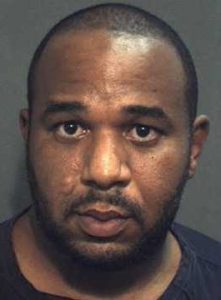 over the Casey Anthony case. Perry’s office said that the judge’s signature was forged in the paperwork calling for reduced sentences for the convicted killers. Apparently, however, while the false documents had problems the one thing that was correct was the judges signature. The judge denies any wrongdoing, saying “It is quite evident that someone forged a court document, filed a motion, and that someone with the aid of a computer, lifted my signature off previous signed documents, which are public reports, affixed that to the document, sent it to the clerk’s office. It was processed and forwarded to doc and the defendant ended up being released,” Perry maintains. He also says, “I have never seen anything like this. You have to give them an A for being imaginative and effective.” The reality is that this was not the first time a prisoner managed to obtain false documents, and probably wont be the last, since no one was caught in this act. The prison waited 17 days before notifying the authorities of the escape. Cybercrime is the newest thing. Easy to perform, hard to catch.
over the Casey Anthony case. Perry’s office said that the judge’s signature was forged in the paperwork calling for reduced sentences for the convicted killers. Apparently, however, while the false documents had problems the one thing that was correct was the judges signature. The judge denies any wrongdoing, saying “It is quite evident that someone forged a court document, filed a motion, and that someone with the aid of a computer, lifted my signature off previous signed documents, which are public reports, affixed that to the document, sent it to the clerk’s office. It was processed and forwarded to doc and the defendant ended up being released,” Perry maintains. He also says, “I have never seen anything like this. You have to give them an A for being imaginative and effective.” The reality is that this was not the first time a prisoner managed to obtain false documents, and probably wont be the last, since no one was caught in this act. The prison waited 17 days before notifying the authorities of the escape. Cybercrime is the newest thing. Easy to perform, hard to catch.
 I think that many of us have thought about a hidden treasure…probably as kids, but maybe as adults too. In fact, with the number of metal detectors sold every year, maybe there are just as many adults looking for hidden treasure as kids.
I think that many of us have thought about a hidden treasure…probably as kids, but maybe as adults too. In fact, with the number of metal detectors sold every year, maybe there are just as many adults looking for hidden treasure as kids.
Dr John Marsh was born June 5, 1799 in South Danvers, Massachusetts. In college at Harvard, he had intended to study ministry, but changed his mind and received his bachelors degree in medicine. He then studied medicine with a Boston doctor. He then decided to move to California, and became an early pioneer and settle in Alta, California. He was also the first Harvard graduate, the first to practice medicine there. He knew Hebrew, Latin and Greek, and was the first to compile a dictionary of the Sioux language. He became one of the wealthiest ranchers in California, and was one of the most influential men in the establishment of California statehood.
The Reverend William W Smith introduced Marsh to Abigail “Abby” Smith Tuck, a schoolteacher from New England, who also served as principal at a girls school in San Jose. After a brief two-week courtship, they were married on June 24, 1851. Soon after the wedding, the couple moved into the old adobe. On 12 March 1852, she gave birth to a daughter they 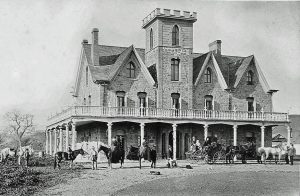 named Alice Frances. Shortly thereafter, Marsh set out to build his family a home. Abby had picked the spot for their home. The home that was nestled in the foothills of Mount Diablo. The home was located next to a creek that was later named Marsh Creek after the doctor. While the home was stunning, the cost of building it did not exceed $20,000.
named Alice Frances. Shortly thereafter, Marsh set out to build his family a home. Abby had picked the spot for their home. The home that was nestled in the foothills of Mount Diablo. The home was located next to a creek that was later named Marsh Creek after the doctor. While the home was stunning, the cost of building it did not exceed $20,000.
Marsh was not only a doctor, but also a rancher, and was very successful, even though he was usually paid for medical services in the currency of the day…cowhides and tallow. Marsh might have been a bit of an eccentric, or maybe he just didn’t trust banks. Whatever the case may be, he was known to bury his money in the foothills near his home. Abby died in 1855, and maybe that was what set Marsh to burying the money. I don’t think anyone knows. It is thought that Marsh buried about $40,000 in gold coins in the area, but the money  has never been found. On September 24, 1856, while coming home from Martinez, Marsh was murdered. It happened on the road between Pacheco and Martinez. Riding by, he was ambushed and murdered by three of his vaquero employees over a dispute about their wages. Two of the killers were found ten years later and brought to trial. One man turned state’s evidence and was released without trial. The other was convicted and sentenced to life in prison, though he was pardoned 25 years later. The third man was never caught. A California Historical Landmark #722 plaque still marks the site of the murder. John and Abigail Marsh are buried in Mountain View Cemetery, in Oakland, California.
has never been found. On September 24, 1856, while coming home from Martinez, Marsh was murdered. It happened on the road between Pacheco and Martinez. Riding by, he was ambushed and murdered by three of his vaquero employees over a dispute about their wages. Two of the killers were found ten years later and brought to trial. One man turned state’s evidence and was released without trial. The other was convicted and sentenced to life in prison, though he was pardoned 25 years later. The third man was never caught. A California Historical Landmark #722 plaque still marks the site of the murder. John and Abigail Marsh are buried in Mountain View Cemetery, in Oakland, California.
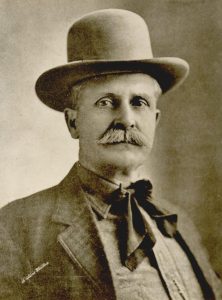 Unfortunately, there are among us, people who are corrupt and ruthless, and sometimes, things happen because of corruption, anger, or even stupidity. William Tilghman was born in Fort Dodge, Iowa on July 4, 1854, at the height of the “Wild West” era. He was a man who wanted something more, so at 16 years old, he moved west. As sometimes happened, men who went west, toyed with the wild life that was brought about by the lawless area. Tilghman was no different. He fell in with a bad crowd of young men who stole horses from the Indians. After several narrow escapes with angry Indians, Tilghman decided that rustling was too dangerous and settled in Dodge City, Kansas, where he briefly served as a deputy marshal before opening a saloon. He was arrested twice for alleged train robbery and rustling, but the charges did not stick. It was a shaky start, but Tilghman gradually built a reputation as an honest and respectable young man in Dodge City. Before long, he became the deputy sheriff of Ford County, Kansas. Later, he was offered and accepted the job of the marshal of Dodge City…a real life Matt Dillon, from Gunsmoke.
Unfortunately, there are among us, people who are corrupt and ruthless, and sometimes, things happen because of corruption, anger, or even stupidity. William Tilghman was born in Fort Dodge, Iowa on July 4, 1854, at the height of the “Wild West” era. He was a man who wanted something more, so at 16 years old, he moved west. As sometimes happened, men who went west, toyed with the wild life that was brought about by the lawless area. Tilghman was no different. He fell in with a bad crowd of young men who stole horses from the Indians. After several narrow escapes with angry Indians, Tilghman decided that rustling was too dangerous and settled in Dodge City, Kansas, where he briefly served as a deputy marshal before opening a saloon. He was arrested twice for alleged train robbery and rustling, but the charges did not stick. It was a shaky start, but Tilghman gradually built a reputation as an honest and respectable young man in Dodge City. Before long, he became the deputy sheriff of Ford County, Kansas. Later, he was offered and accepted the job of the marshal of Dodge City…a real life Matt Dillon, from Gunsmoke.
Tilghman was one of the first men into the territory when Oklahoma opened to settlement in 1889, and he became a deputy US marshal for the region in 1891. In the late 19th century, lawlessness was still very much a part of Oklahoma. Tilghman helped to bring order the to area by ridding Oklahoma by capturing some of the most notorious bandits of the day. While locking up many criminals, Tilghman, nevertheless, managed to earn a well-deserved reputation for treating even the worst criminals fairly and protecting the rights of the unjustly accused. Any man, who found himself in Tilghman’s custody, knew he was safe from angry vigilante mobs, 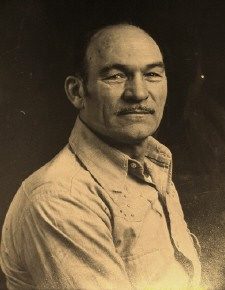 because Tilghman had little tolerance for those who took the law into their own hands. In 1898, a wild mob lynched two young Indians who were falsely accused of raping and murdering a white woman. Tilghman arrested and secured prison terms for eight of the mob leaders and captured the real rapist-murderer.
because Tilghman had little tolerance for those who took the law into their own hands. In 1898, a wild mob lynched two young Indians who were falsely accused of raping and murdering a white woman. Tilghman arrested and secured prison terms for eight of the mob leaders and captured the real rapist-murderer.
In 1924, after serving a term as an Oklahoma state legislator, making a movie about his frontier days, and serving as the police chief of Oklahoma City, Tilghman might well have been expected to quietly retire. However, it was the height of the Prohibition era, and the old lawman was unable to hang up his gun. He still felt a calling to keep law and order in his town. He accepted a job as city marshal in Cromwell, Oklahoma. On November 1, 1924, William Tilghman, who was known to both friends and enemies alike as “Uncle Billy” was murdered by a corrupt prohibition agent who resented Tilghman’s refusal to ignore local bootlegging operations. The Prohibition officer was drunk, and in his anger, made the worst mistake of his life.
 Everyone knows the horrors of the Nazi regime, but few people can say that while they thought it was all a part of war, until one day they were forced to see it for what it really was…horrible. These soldiers honestly thought that the concentration camps were no different than the prisoner of war camps they were in, but when they saw the truth, it made them sick. They were forced to face the awful truth that their leader was a complete monster…and worse yet, that they could do nothing to stop his tirade. This forced confrontation brought Germans face-to-face with the worst works of the Third Reich. I can’t imagine the horror of finding out that human beings were being murdered in the gas chambers. The absolute horror of it shows on the faces of the prisoners of war in the United States camps, as they compared the treatment they received at our hands, to what the Nazis were doing to the Jewish people.
Everyone knows the horrors of the Nazi regime, but few people can say that while they thought it was all a part of war, until one day they were forced to see it for what it really was…horrible. These soldiers honestly thought that the concentration camps were no different than the prisoner of war camps they were in, but when they saw the truth, it made them sick. They were forced to face the awful truth that their leader was a complete monster…and worse yet, that they could do nothing to stop his tirade. This forced confrontation brought Germans face-to-face with the worst works of the Third Reich. I can’t imagine the horror of finding out that human beings were being murdered in the gas chambers. The absolute horror of it shows on the faces of the prisoners of war in the United States camps, as they compared the treatment they received at our hands, to what the Nazis were doing to the Jewish people.
An important part of keeping moral up in any war is making sure that the people believe that what their nation is doing, is the right thing. To find out that their nation…their leader, Hitler…was involved in the unwarranted killing of human beings, just because these people were a race they did not like, had to have been such a shock…a sickening shock. This forced process was part of the Allied policy known as denazification, which was designed to to purge Germany of the remnants of Nazi rule and rebuild its civil society, infrastructure, and economy. The program included actual visits to nearby concentration camps. Posters displaying dead bodies of prisoners hung in public places, and forced German prisoners of war to view films documenting the Nazis’ treatment of “inferior” people. The German people had to be changed. They had to realize that Hitler’s evil agenda could not continue. The only way to do that was to change the hearts of men. The best way to change the hearts of men is to show them the horrible truth that they have been lied too and taken advantage of.
While such a harsh method designed to facilitate change was necessary, I must think that it was as hard on the Americans as it was on the Germans. I don’t think anyone could easily watch such horrible murders, without feeling something…except maybe Hitler and his serious henchmen. I still believe that the majority of human beings cannot easily stomach blatant hatred, and horrific murder. I can’t say exactly how big an impact the denazification efforts had at that time in history, but I believe that it was huge. The reason is that the German 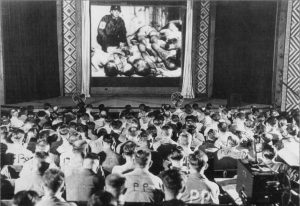 soldiers weren’t necessarily Nazis, and the Holocaust was just one side of the World War II. They were also fighting for territory and power. Strong nationalistic feelings were quite normal back then. Oddly, no conflict existed between not following the Nazis and fighting for the “good of your Fatherland.” Some soldiers were Nazis, some just wanted revenge for Versailles, others wanted to sit at the same table as France and Britain. And many followed because they had no other choice. It was a very strange situation, and one that had to be changed. It may not have been a humane way to bring change, but it was all they could do, so denazification was what they did…and at that time, it worked.
soldiers weren’t necessarily Nazis, and the Holocaust was just one side of the World War II. They were also fighting for territory and power. Strong nationalistic feelings were quite normal back then. Oddly, no conflict existed between not following the Nazis and fighting for the “good of your Fatherland.” Some soldiers were Nazis, some just wanted revenge for Versailles, others wanted to sit at the same table as France and Britain. And many followed because they had no other choice. It was a very strange situation, and one that had to be changed. It may not have been a humane way to bring change, but it was all they could do, so denazification was what they did…and at that time, it worked.

